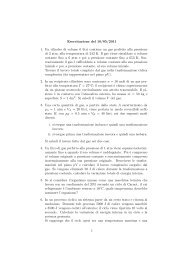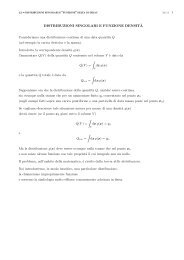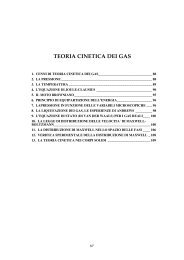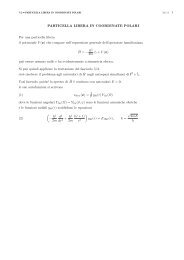PARTICELLA CARICA IN UN CAMPO ELETTROMAGNETICO ...
PARTICELLA CARICA IN UN CAMPO ELETTROMAGNETICO ...
PARTICELLA CARICA IN UN CAMPO ELETTROMAGNETICO ...
You also want an ePaper? Increase the reach of your titles
YUMPU automatically turns print PDFs into web optimized ePapers that Google loves.
9/1 <strong>PARTICELLA</strong> <strong>IN</strong> <strong>UN</strong> <strong>CAMPO</strong> <strong>ELETTROMAGNETICO</strong> 11/12 2Campo magnetico costante e uniformeSe E(x, t) = 0, B(x, t) = B 0si può prendereV = 0,A = 1 2 B 0 ∧ x (∇·A = 0).Poiché B 0 ∧ ˆx · ˆp = B 0 · ˆx ∧ ˆp = B 0· ˆl = ħ B 0· ˆl l’espressione (2) diventa(3) Ĥ = ˆp22m − ħq2mc B 0· ˆl +q28mc 2 (B 0 ∧ ˆx) 2 + Û.Per l’elettrone q = −e 0 , m = m e ,e quindie 0 ħ2m e c = µ B(4) Ĥ = ˆp22m e+ µ B B 0· ˆl + e2 08m e c 2 (B 0 ∧ ˆx) 2 + Û.Per campi B 0 sufficientemente deboli(5) Ĥ = ˆp22m e+ µ B B 0· ˆl + Û.
9/1 <strong>PARTICELLA</strong> <strong>IN</strong> <strong>UN</strong> <strong>CAMPO</strong> <strong>ELETTROMAGNETICO</strong> 11/12 3<strong>PARTICELLA</strong> <strong>CARICA</strong> E DOTATA DI MOMENTO MAGNETICOConsideriamo ora una particella di carica q<strong>IN</strong> <strong>UN</strong> <strong>CAMPO</strong> <strong>ELETTROMAGNETICO</strong>dotata di un momento angolare meccanico intrinseco sqe di un momento magnetico intrinseco µ s = g s2mc sche si muova in un campo elettromagnetico dato dal campo elettrico E e dal campo magnetico B.Descrizione classicaIn meccanica classica la dinamica è specificata dalla funzione hamiltonianadove il terzo termineH = 1 (p − q ) 22m c A + q V − µs · B −mc 1 (µ s −q2mc s) · E ∧ p + Urappresenta l’energia di un dipolo magnetico in un campo magnetico,il quarto terminecorrisponde alla coppia che si esercita su un dipolo magnetico che si muove in un campo elettrico,e il quinto termine descrive un’ulteriore energia potenziale eventualmente presente.Descrizione quantisticaIn meccanica quantistica assumiano che l’operatore hamiltoniano si ottenga con le sostituzionix → ˆx, p → ˆp, s → ŝ = ħŝ µ s → ˆµ s = g sħq2mc ŝ = g sµ ŝL’operatore hamiltoniano è dunque(6) Ĥ = 1 (ˆp − q Â) 22m c + q ˆV − gs µ ŝ · ˆB − (g s − 1) µ mc ŝ ·Ê ∧ ˆp + Û.NotaL’unico problema di ordine è dato dall’espressione Ê ∧ ˆp.Il problema non sussiste nel caso statico.Da [ˆp j , f(ˆx) ] = −iħ ∂f ❏e Ê k = − ∂V♣ ◆∂x j∂x ksegue(Ê ∧ ˆp) i = ∑ ε ijkjk Êj ˆp k = ∑ ε ijk ˆp k Ê j − iħ ∑ ♠♠◗◗ε ∂ 2 Vijk = −( ˆp ∧jk jk ∂x j ∂x Ê) i .k} {{ } = 0


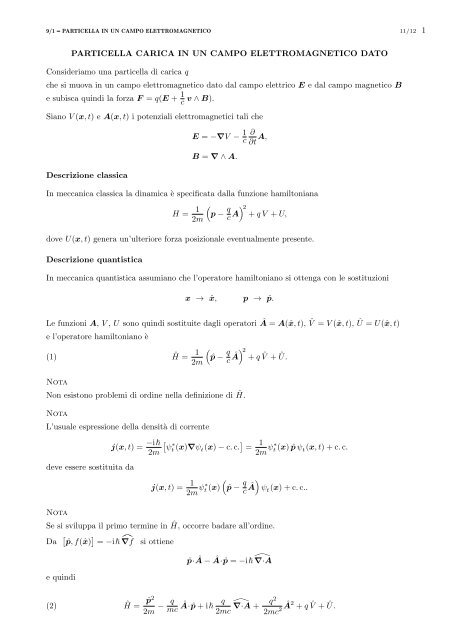
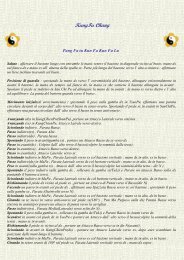


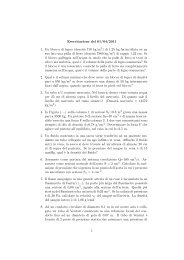
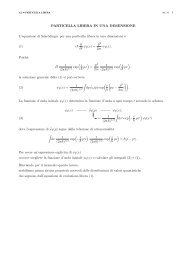
![[Type the document title] Point Location for Dim-Mak ... - Tai Chi World](https://img.yumpu.com/45924765/1/190x245/type-the-document-title-point-location-for-dim-mak-tai-chi-world.jpg?quality=85)
